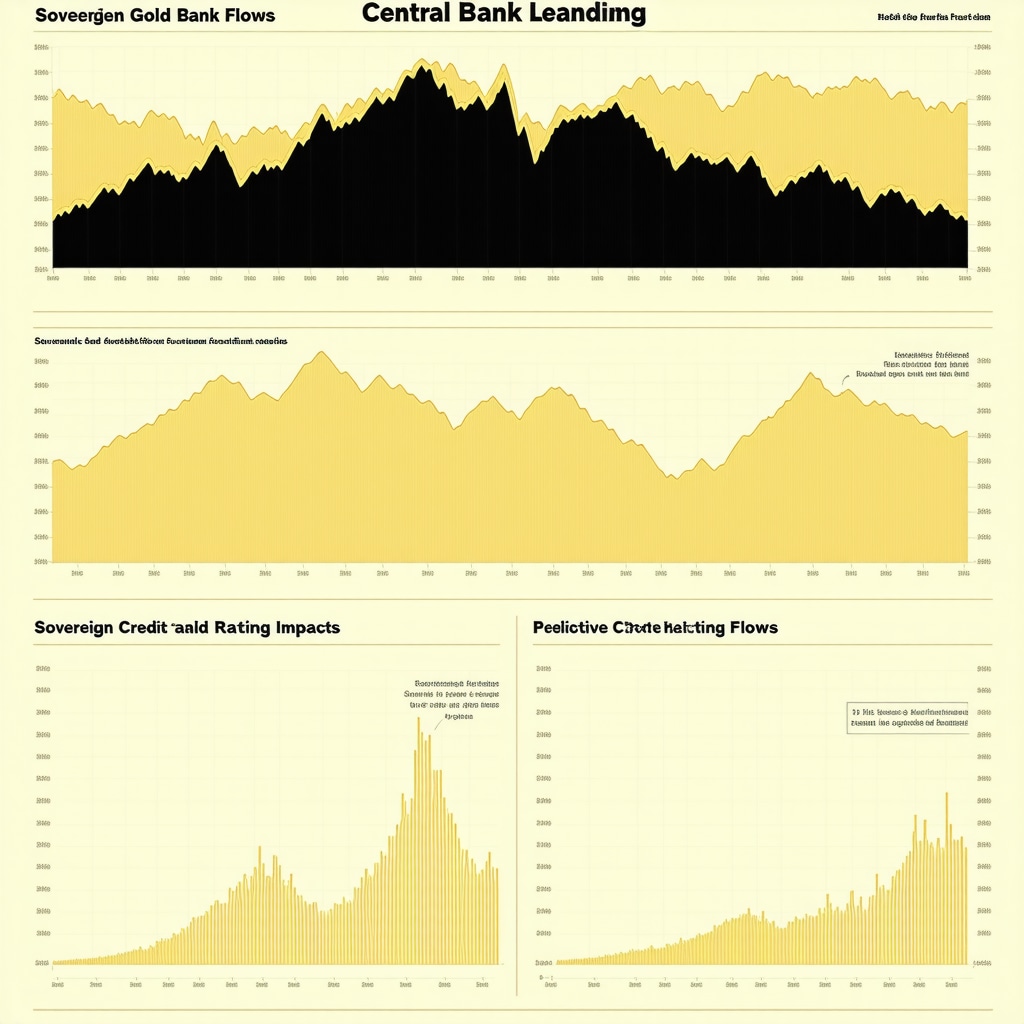Unveiling the Strategic Role of Central Banks in Gold Markets
Central banks’ gold purchases are more than mere additions to their reserves—they serve as powerful signals for investors and analysts seeking to decode future market directions. Understanding the nuances behind these acquisitions can unlock predictive insights into monetary policy shifts, inflation expectations, and geopolitical risk assessments. This article dives deep into how central bank gold buying patterns influence the global gold market and how savvy market participants can harness this information for strategic forecasting.
Decoding Central Bank Accumulation: What Drives the Demand?
Unlike typical investors, central banks accumulate gold with multifaceted motivations: diversification away from fiat currencies, safeguarding against currency devaluation, and reinforcing financial stability amid geopolitical tensions. For instance, post-2008 financial crisis, many central banks aggressively increased their gold holdings as a hedge against systemic risks. Such behavior signals potential shifts in global economic confidence, often preceding notable price movements in gold markets. By analyzing these buying patterns, investors can anticipate macroeconomic trends and adjust portfolios accordingly.
How Can Central Bank Gold Purchases Forecast Market Volatility and Inflation?
Central bank gold accumulation often correlates with rising concerns over inflation and currency instability. When central banks increase their gold reserves, it typically reflects an anticipation of inflationary pressures or a lack of trust in conventional monetary tools. For example, the World Gold Council reported a surge in central bank gold buying in recent years coinciding with rising inflation fears globally (World Gold Council on Central Bank Gold Purchases). This behavior can presage increased market volatility as investors seek safe-haven assets. Monitoring central bank disclosures and purchases provides a leading indicator of such economic environments.
Case Study: The Ripple Effects of Russia and China’s Gold Accumulation
Russia and China have notably expanded their gold reserves over the past decade, reshaping the dynamics of global gold demand. Russia’s strategic purchases, often synchronized with geopolitical tensions and sanctions, serve as a buffer against dollar dependency. Meanwhile, China’s gold accumulation aligns with its long-term goal to internationalize the yuan and strengthen financial sovereignty. These coordinated actions have contributed to upward pressure on gold prices and underscore the importance of geopolitical context when interpreting central bank buying activity.
Integrating Central Bank Signals into Investment Strategies
For investors, incorporating central bank gold purchase trends can enhance the robustness of market forecasts. Monitoring monthly and quarterly reports from the International Monetary Fund and the World Gold Council allows timely insights into reserve changes. Combining this data with analysis of emerging market demand trends can highlight shifting supply-demand dynamics (Gold Demand Trends in Emerging Markets). Strategic investors might also explore diversified gold investment vehicles—such as ETFs and mutual funds—that can leverage these macro signals for growth, as discussed in expert guides on selecting top gold ETFs and mutual funds.
Spotting Early Warnings: Beyond Numbers to Contextual Analysis
Numbers alone don’t tell the whole story. Contextualizing central bank gold purchases within geopolitical events, monetary policy announcements, and currency fluctuations is crucial. For example, a sudden increase in gold reserves amid rising geopolitical tensions often signals a flight to safety that precedes market turbulence. Experienced analysts combine quantitative data with qualitative assessments to forecast price movements more accurately and advise investors accordingly.
Understanding these complex interplays offers a competitive edge in anticipating gold price trajectories and managing risks effectively.
If you found these insights valuable, share your thoughts or questions below to join an expert community navigating gold market complexities.
Central Banks and Gold Liquidity: What Does This Mean for Market Stability?
Central banks do not only accumulate gold; they also manage its liquidity to maintain financial stability. Gold lending and leasing programs, although less publicized, play a pivotal role in the gold market ecosystem. Central banks may lend gold to bullion banks or other financial institutions to support liquidity during periods of high demand or market stress. This mechanism helps moderate price volatility by ensuring supply availability when physical gold demand surges.
However, the unwinding of such lending programs or unexpected changes in gold liquidity can act as a catalyst for sharp price movements. Investors who monitor not just the volume of gold purchases but also the flow and availability of gold in the market gain a nuanced understanding of potential supply constraints and consequent price implications.
How Do Central Bank Gold Holdings Influence Currency Strength and Sovereign Risk?
Gold holdings are a critical component of a central bank’s foreign reserves, impacting the perceived creditworthiness and currency stability of their respective countries. When central banks boost gold reserves, it often signals a strategic move to reduce reliance on volatile fiat currencies, especially the U.S. dollar. This diversification enhances the resilience of national reserves against currency depreciation risks.
Moreover, rising gold reserves can be interpreted by credit rating agencies and international investors as a buffer against sovereign risk, potentially improving sovereign bond ratings. This feedback loop can have profound implications for government borrowing costs and fiscal policy flexibility.
What Are the Practical Steps Investors Can Take to Incorporate Central Bank Gold Trends into Portfolio Management?
Integrating central bank gold purchase data into investment strategy requires a multi-dimensional approach. First, investors should regularly review official reports from the International Monetary Fund and the World Gold Council, which provide comprehensive updates on reserve compositions and gold buying activity. Coupling this data with geopolitical risk assessments and currency market analysis sharpens timing and allocation decisions.
Second, diversifying exposure through gold-related financial instruments such as ETFs, mutual funds, and mining stocks can offer tailored risk-return profiles suited to individual portfolio objectives. For example, understanding which ETFs track physical gold versus those investing in gold equities can influence performance during different market cycles (selecting top gold ETFs and mutual funds).
Finally, adopting active monitoring of global gold demand trends—especially in emerging markets—and central bank purchases can reveal early signals of market shifts, allowing proactive portfolio adjustments (Gold Demand Trends in Emerging Markets).
Emerging Market Central Banks: Catalysts for Gold Price Dynamics
Emerging market central banks are increasingly influential players in the gold market landscape. Countries such as India, Turkey, and several in Southeast Asia have scaled up their gold reserves as part of broader economic strategies to stabilize local currencies and hedge against external volatility. Their purchasing patterns often reflect regional economic conditions, currency pressures, and geopolitical developments.
This trend, combined with rising consumer demand in these markets, creates a potent dual impact on gold prices. Understanding these regional nuances allows investors to anticipate not only global but also localized gold price drivers, enriching market forecasts and investment timing.
Evaluating the Role of Transparency and Reporting in Central Bank Gold Movements
One complexity investors face is the varying degrees of transparency in central bank gold reporting. While some central banks provide detailed, timely data on their gold holdings, others disclose information sporadically or with significant delays. This opacity can mask true market supply dynamics and impede accurate forecasting.
Consequently, expert investors leverage alternative data sources—such as import-export records, vault audits by independent firms, and market rumors—to triangulate central bank activity. Combining these insights with official releases forms a comprehensive picture of gold market fundamentals essential for sophisticated investment strategies.
For further detailed analysis on gold market dynamics including central bank influences, consider exploring expert content on global gold market trends and price prediction.
What are your thoughts on how central bank gold purchases might reshape investment portfolios in an increasingly volatile economic landscape? Share your insights or questions below to engage with a community of gold market experts.
Central Bank Gold Lending: The Underexplored Lever of Market Liquidity and Stability
While central banks are primarily known for their gold accumulation, their role in gold liquidity management through lending and leasing programs is a sophisticated facet often overlooked in mainstream analysis. These programs enable central banks to lend physical gold to bullion banks and financial institutions, thereby enhancing market liquidity during periods of heightened demand or financial stress. The strategic deployment of gold lending acts as a shock absorber, tempering price volatility by supplying gold when physical demand surges beyond mine production and recycling capacity.
However, the termination or contraction of these lending programs can trigger abrupt supply shortages, creating sharp upward pressure on gold prices. For example, historical data reveals that during the early 2010s, the gradual winding down of gold leasing coincided with a rebound in gold prices, highlighting the tether between liquidity provision and price dynamics (LBMA Historical Gold Leasing Analysis). Advanced investors monitor these lending trends through LBMA reports and market intelligence to anticipate potential liquidity squeezes and ensuing price spikes.
Interlinking Gold Reserves and Currency Strength: Sovereign Risk Reassessment and Macroeconomic Implications
Central banks’ augmentation of gold reserves extends beyond portfolio diversification; it intrinsically influences currency valuation and sovereign creditworthiness. Gold acts as a tangible reserve asset that can stabilize national currency by reducing exposure to foreign exchange volatility, particularly against dominant reserve currencies like the U.S. dollar. This diversification mitigates the risk of currency depreciation stemming from geopolitical uncertainties or monetary policy shifts.
Moreover, credit rating agencies factor in gold reserve levels when evaluating sovereign risk profiles. An increase in gold holdings can signal fiscal prudence and enhanced reserve quality, potentially leading to improved sovereign bond ratings and lower government borrowing costs. This dynamic creates a positive feedback loop where currency stability and sovereign creditworthiness mutually reinforce each other, influencing investor confidence and capital flows.
How Do Central Bank Gold Holdings Impact Sovereign Credit Ratings and Currency Stability in Emerging Economies?
Emerging market central banks that strategically increase gold reserves often do so to buffer against external shocks and currency volatility. For these economies, gold serves as a hedge against abrupt capital outflows and exchange rate turbulence. Credit rating agencies, such as Moody’s and S&P Global, recognize the role of robust gold reserves in enhancing a country’s debt-servicing capacity and reserve adequacy metrics.
For instance, research published in the Journal of International Money and Finance highlights that countries with higher gold reserve ratios tend to exhibit lower sovereign risk premiums and more stable currency exchange rates (Impact of Gold Reserves on Sovereign Risk and Currency Stability). Investors focusing on emerging markets should thus integrate central bank gold reserve trends into their macroeconomic risk assessments to refine portfolio risk management.
Leveraging Central Bank Gold Purchase Data: Advanced Analytical Techniques for Portfolio Optimization
Incorporating central bank gold buying patterns into investment strategies demands a holistic and data-driven approach. Beyond tracking headline purchase volumes, sophisticated investors analyze temporal purchasing patterns, geopolitical event correlations, and monetary policy communications to discern subtle market signals.
Advanced tools such as machine learning algorithms can be employed to model the complex interdependencies between central bank gold acquisitions, currency fluctuations, inflation expectations, and gold price movements. These predictive analytics enable proactive portfolio rebalancing and risk mitigation, capitalizing on early warning indicators embedded in central bank behavior.
Furthermore, integrating alternative data sources—such as logistics tracking of gold shipments, vault audit reports, and real-time market sentiment analysis—augments traditional data streams, offering a multi-dimensional perspective on gold market dynamics. Investors interested in deploying such techniques may explore expert resources on quantitative gold investment strategies and data integration platforms.
Engage with our expert community by sharing your strategies or inquiries about leveraging central bank gold data for portfolio enhancement below.
Unraveling the Intricacies of Central Bank Gold Lending and Market Liquidity
Central banks’ gold lending mechanisms constitute a nuanced lever of market liquidity management often obscured by the prominence of reserve accumulation. These gold lending and leasing arrangements provide critical short-term liquidity to bullion banks and financial entities, effectively smoothing supply-demand imbalances during periods of acute physical gold demand or systemic market stress. The strategic modulation of these lending programs can attenuate price volatility, acting as a financial shock absorber within the gold ecosystem.
However, investors must remain vigilant to the risks posed by the contraction or cessation of such lending activities, which historically precipitate supply constraints and notable price surges. For example, documented trends from the London Bullion Market Association’s historical analysis illustrate how the phased reduction of gold leasing in the early 2010s correlated with a significant rebound in gold valuations. Advanced market participants who monitor LBMA reports and leverage market intelligence on lending flows position themselves to anticipate liquidity-induced price inflections with greater precision.
Interdependencies Between Gold Reserves, Currency Valuation, and Sovereign Creditworthiness
Augmentation of gold reserves by central banks transcends portfolio diversification; it directly informs sovereign credit evaluations and currency stability metrics. Gold’s intrinsic value as a tangible reserve asset mitigates exposure to fiat currency volatility, particularly vis-à-vis dominant reserve currencies like the U.S. dollar. This strategic diversification bolsters national currency resilience amidst geopolitical uncertainties and monetary policy fluctuations.
Concurrently, credit rating agencies integrate gold reserve metrics into sovereign risk appraisals. Elevated gold holdings convey fiscal robustness and enhanced reserve quality, factors that can precipitate improved sovereign bond ratings and reduced government borrowing costs. This symbiotic relationship fosters a reinforcing cycle between currency stability and sovereign creditworthiness, ultimately shaping investor confidence and cross-border capital flows.
How Do Central Bank Gold Holdings Impact Sovereign Credit Ratings and Currency Stability in Emerging Economies?
Emerging market central banks increasingly deploy gold reserves as a bulwark against external shocks and exchange rate volatility. Research published in the Journal of International Money and Finance elucidates that nations with higher gold reserve ratios experience diminished sovereign risk premiums and enhanced currency stability (Impact of Gold Reserves on Sovereign Risk and Currency Stability). This empirical evidence underscores the imperative for investors focusing on emerging markets to integrate central bank gold reserve trends within macroprudential risk frameworks to optimize portfolio resilience.
Harnessing Predictive Analytics and Alternative Data to Decode Central Bank Gold Movements
Incorporating central bank gold purchasing dynamics into investment decision-making mandates a sophisticated, data-centric methodology. Beyond mere tracking of acquisition volumes, expert investors analyze temporal purchasing patterns, geopolitical catalysts, and policy communications to uncover latent market signals.
Advanced quantitative methods, including machine learning algorithms, facilitate modeling of intricate interrelations among central bank gold acquisitions, currency fluctuations, inflation expectations, and price trajectories. These analytic capabilities empower proactive portfolio rebalancing and risk mitigation, capitalizing on early-warning indicators inherent in central bank conduct.
Complementing conventional data streams with alternative intelligence—such as logistics tracking of gold shipments, independent vault audits, and sentiment analysis—provides a multidimensional perspective essential for mastering gold market complexities. Professionals seeking to deploy these advanced strategies may consult specialized resources on quantitative gold investment frameworks and integrated data platforms.
Explore these cutting-edge approaches and share your inquiries or strategies below to engage with a network of market experts committed to elevating gold investment acumen.

Frequently Asked Questions (FAQ)
Why do central banks buy gold instead of other assets?
Central banks purchase gold primarily as a strategic reserve asset to diversify away from fiat currencies, hedge against inflation and currency devaluation, and enhance financial stability during geopolitical or economic uncertainty. Unlike other assets, gold has intrinsic value, is globally recognized, and tends to retain purchasing power over long periods, making it a reliable store of value.
How can tracking central bank gold purchases help forecast gold price movements?
Central bank gold buying often precedes shifts in monetary policy, inflation expectations, or geopolitical risks. Increased accumulation signals concerns about currency stability or inflation, which can lead to higher gold demand and price appreciation. By analyzing central bank reserve reports and purchase trends, investors gain early insight into macroeconomic trends that influence gold prices.
What role do gold lending and leasing programs play in market stability?
Gold lending and leasing by central banks provide necessary liquidity to bullion banks and financial institutions during periods of high physical gold demand or market stress. These programs help moderate price volatility by ensuring supply availability. However, contraction or termination of lending can cause supply shortages, triggering sharp price increases.
How does central bank gold accumulation influence currency strength and sovereign credit ratings?
Increasing gold reserves reduces reliance on volatile fiat currencies and enhances reserve quality, which can stabilize national currencies. Credit rating agencies view robust gold holdings as a sign of fiscal prudence, potentially improving sovereign credit ratings and lowering borrowing costs. This dynamic strengthens investor confidence and supports currency stability.
Are emerging market central banks significant drivers of global gold demand?
Yes, emerging market central banks like those in India, Turkey, and Southeast Asia have become influential in gold markets by increasing reserves to stabilize local currencies and hedge external risks. Their buying patterns, combined with rising consumer demand in these regions, significantly impact global gold price dynamics.
How reliable is the transparency of central bank gold reporting?
Transparency varies widely among central banks; some provide timely, detailed data while others disclose information irregularly or with delays. This opacity complicates accurate market assessment. Therefore, investors often use alternative data sources such as import-export records, independent vault audits, and market intelligence to triangulate central bank activity.
What advanced analytical methods can investors use to interpret central bank gold trends?
Investors increasingly apply machine learning algorithms and predictive analytics to model relationships among central bank gold purchases, currency movements, inflation expectations, and gold prices. Combining structured data with alternative sources like shipment logistics and sentiment analysis provides a comprehensive view that supports proactive portfolio management.
How do central bank gold holdings affect risk management in investment portfolios?
Tracking central bank gold accumulation helps investors anticipate macroeconomic risks such as inflation, currency volatility, and geopolitical instability. Incorporating these signals into portfolio strategies through diversified gold investments—ETFs, mutual funds, mining stocks—enhances risk-adjusted returns and hedges against market downturns.
What are the challenges in using central bank gold purchase data for investment decisions?
Challenges include inconsistent reporting schedules, incomplete data disclosure, and the need to contextualize purchases within broader geopolitical and economic frameworks. Overcoming these requires integrating multiple data sources and qualitative analysis to accurately interpret market signals.
Can central bank gold buying signal changes in global monetary policy?
Yes, shifts in central bank gold reserves often reflect changes in monetary policy stance or confidence in fiat currencies. For example, increased gold purchases may indicate expectations of inflationary policy or a strategic move to reduce exposure to dominant reserve currencies, signaling potential shifts in global financial dynamics.
Trusted External Sources
- World Gold Council (WGC): The premier authority on gold market statistics and central bank gold purchases. WGC provides comprehensive data and research on global gold demand, offering invaluable insights into reserve trends and their market implications.
- International Monetary Fund (IMF): IMF’s official reports on member countries’ reserve compositions and gold holdings are critical for tracking central bank activity and understanding macroeconomic impacts worldwide.
- London Bullion Market Association (LBMA): LBMA’s historical analyses and reports on gold lending and leasing programs offer expert perspectives on gold liquidity management and its influence on market stability.
- Journal of International Money and Finance: Peer-reviewed academic research published here includes empirical studies on the effects of gold reserves on sovereign risk and currency stability, particularly valuable for emerging market analysis.
- Credit Rating Agencies (Moody’s, S&P Global): These agencies incorporate gold reserve data into sovereign credit assessments. Their reports help investors understand how gold holdings influence sovereign risk profiles and borrowing costs.
Conclusion
Central bank gold purchases are a pivotal yet often underappreciated force shaping global gold markets and broader economic dynamics. These acquisitions not only signal shifts in monetary policy and inflation expectations but also influence currency stability and sovereign creditworthiness. By integrating detailed central bank gold data with geopolitical and macroeconomic analysis, investors can unlock powerful forecasting insights and refine portfolio strategies to mitigate risk and capitalize on emerging opportunities.
Moreover, understanding the intricate role of gold lending programs and varying transparency levels enhances market liquidity awareness, enabling more nuanced investment decisions. Advanced analytical tools, including predictive modeling and alternative data integration, empower market participants to decode complex central bank behaviors and anticipate price movements with greater precision.
Harnessing these expert insights into central bank gold buying patterns equips investors with a strategic advantage in navigating volatile economic landscapes. We encourage you to apply this knowledge, share your perspectives, and explore related expert content to deepen your mastery of gold market complexities.










